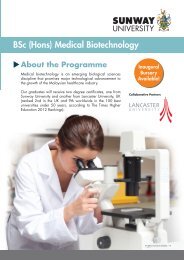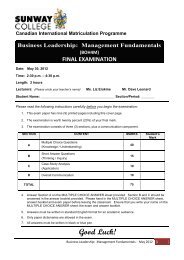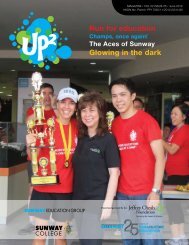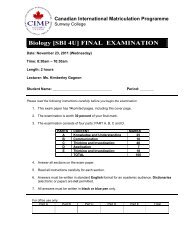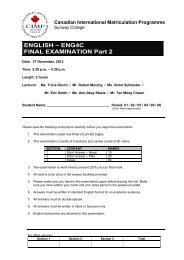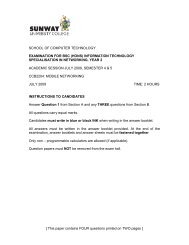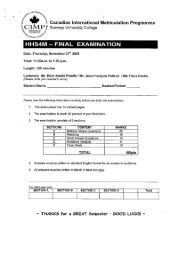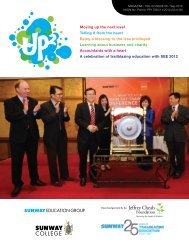[This paper contains SIX questions printed on THREE pages ...
[This paper contains SIX questions printed on THREE pages ...
[This paper contains SIX questions printed on THREE pages ...
Create successful ePaper yourself
Turn your PDF publications into a flip-book with our unique Google optimized e-Paper software.
SCHOOL OF COMPUTER TECHNOLOGY<br />
EXAMINATION FOR BSC (HONS) INFORMATION TECHNOLOGY<br />
SPECIALISATION IN NETWORKING, YEAR 3<br />
ACADEMIC SESSION 2009, SEMESTER 8 & 9<br />
CCB3304: SATELLITE COMMUNICATION<br />
MARCH 2009<br />
TIME: 2 HOURS<br />
INSTRUCTIONS TO CANDIDATES<br />
Answer any FOUR <str<strong>on</strong>g>questi<strong>on</strong>s</str<strong>on</strong>g>.<br />
All <str<strong>on</strong>g>questi<strong>on</strong>s</str<strong>on</strong>g> carry equal marks.<br />
Candidates must write in blue or black INK when writing in the answer booklet.<br />
All answers must be written in the answer booklet provided. At the end of the<br />
examinati<strong>on</strong>, answer booklets and answer sheets must be fastened together.<br />
Only n<strong>on</strong> – programmable calculators are allowed (if applicable).<br />
Questi<strong>on</strong> <str<strong>on</strong>g>paper</str<strong>on</strong>g>s must NOT be removed from the exam hall.<br />
[<str<strong>on</strong>g>This</str<strong>on</strong>g> <str<strong>on</strong>g>paper</str<strong>on</strong>g> <str<strong>on</strong>g>c<strong>on</strong>tains</str<strong>on</strong>g> <str<strong>on</strong>g>SIX</str<strong>on</strong>g> <str<strong>on</strong>g>questi<strong>on</strong>s</str<strong>on</strong>g> <str<strong>on</strong>g>printed</str<strong>on</strong>g> <strong>on</strong> <strong>THREE</strong> <strong>pages</strong>]
Questi<strong>on</strong> 1 (25 marks)<br />
a) Provide FIVE different types of satellites that were launched<br />
between the years 1957 to 1967.<br />
b) Briefly define the following Kepler’s law:<br />
i. First Kepler’s Law<br />
ii. Sec<strong>on</strong>d Kepler’s Law<br />
iii. Third Kepler’s Law<br />
(5 marks)<br />
(2 marks)<br />
(2 marks)<br />
(2 marks)<br />
c) Briefly explain the following types of satellites:<br />
i. The Low Earth Orbit (LEO) satellite<br />
ii. The Medium Altitude Orbit (MEO) satellite<br />
(7 marks)<br />
(7 marks)<br />
Questi<strong>on</strong> 2 (25 marks)<br />
a) An earth stati<strong>on</strong> is located in Washingt<strong>on</strong> DC and the<br />
Geosynchr<strong>on</strong>ous satellite (GOS) is located at 97°W. The<br />
following are the parameters of the earth stati<strong>on</strong> and the<br />
satellite:<br />
Earth Stati<strong>on</strong>:<br />
Latitude (L E ) = 39°N = +39<br />
L<strong>on</strong>gitude (I E ) = 77°W = -77<br />
Altitude = H = 0 km<br />
GOS Satellite:<br />
Latitude (L S ) = 0° (Inclinati<strong>on</strong> angle = 0)<br />
L<strong>on</strong>gitude (I S ) = 97°W = -97<br />
Find the followings based <strong>on</strong> the informati<strong>on</strong> given in figures Q2<br />
(a) and Table Q2 (a) :<br />
i. The range, d<br />
ii. The Elevati<strong>on</strong> angle, θ<br />
iii. The azimuth angle, φ z<br />
(8 marks)<br />
(3 marks)<br />
(7 marks)<br />
CCB3304: Satellite Communicati<strong>on</strong><br />
1<br />
(March 2009)
) A Low Earth Orbit (LEO) satellite is in a circular orbit 322 km<br />
above the earth. Assume the average radius of the earth is 6378<br />
km and the earth eccentricity is 0.<br />
i. Determine the orbital velocity of the satellite in m/sec<br />
ii. What is the orbital period, in minutes, of the LEO<br />
satellite?<br />
(3 marks)<br />
(4 marks)<br />
Questi<strong>on</strong> 3 (25 marks)<br />
a) Briefly explain the following functi<strong>on</strong>s in a satellite system:<br />
i. Tracking<br />
ii. Telemetry<br />
iii. Command<br />
b) Calculate the following antenna parameters:<br />
i. The gain in dBi of a 3m parabolic reflector antenna at<br />
frequencies of 6 GHz and 14 GHz;<br />
ii. The gain in dBi and the effective area of a 30m parabolic<br />
antenna at 4 GHz<br />
(5 marks)<br />
(5 marks)<br />
(5 marks)<br />
(6 marks)<br />
(4 marks)<br />
Questi<strong>on</strong> 4 (25 marks)<br />
a) C<strong>on</strong>sider a satellite link that operates in ‘KU-Band’ and the<br />
parameters are shown in figure Q4 (a). The transmit power is 10<br />
watts, and both the transmitter and receiver parabolic antennas<br />
have a diameter of 3 m. The antenna efficiency is 55% for both<br />
antennas. The satellite is in a GSO locati<strong>on</strong>, with a range of 35<br />
900 km. The frequency of operati<strong>on</strong> is 12 GHz. These are typical<br />
parameters for a moderate rate private network VSAT uplink<br />
terminal.<br />
Determine:<br />
i. The received power (pr)<br />
ii. The power flux density (pfd) for the link<br />
(10 marks)<br />
(5 marks)<br />
Figure Q4 (a)<br />
b)<br />
CCB3304: Satellite Communicati<strong>on</strong><br />
2<br />
(March 2009)
c<br />
Briefly explain the c<strong>on</strong>cepts of using Carrier to Noise Density ( ) n<br />
e b<br />
and ( ) Energy Per-bit to Noise Density in measuring the Radio<br />
n 0<br />
Frequency (RF) link performance in satellite communicati<strong>on</strong>s.<br />
(10 marks)<br />
Questi<strong>on</strong> 5 (25 marks)<br />
a) A satellite at 40,000 km transmits 2W of power. The antenna gain<br />
is 17 dB. Calculate:<br />
i) The flux density <strong>on</strong> the earth’s surface<br />
ii) The power received by the antenna with effective aperture of<br />
10m 2<br />
iii) The gain of the receiving antenna<br />
i) The receiver Carrier to Noise ratio C/N, assuming system<br />
temperature (Ts) is 152 K, and bandwidth (BW) is 500 MHz<br />
b) Briefly explain the influence of cloud and fog attenuati<strong>on</strong>s in a<br />
satellite communicati<strong>on</strong> system.<br />
(4 marks)<br />
(4 marks)<br />
(3 marks)<br />
(4 marks)<br />
(10 marks)<br />
Questi<strong>on</strong> 6 (25 marks)<br />
a) Why is it that Beam Diversity and Power C<strong>on</strong>trol techniques do<br />
not alter basic signal format in the process of restoring the<br />
communicati<strong>on</strong> link?<br />
b) Frequency Divisi<strong>on</strong> Multiple Access (FDMA) was the first Multiple<br />
Access (MA) technique to be implemented <strong>on</strong> satellite systems<br />
and is the simplest in principle and operati<strong>on</strong>. Sketch a design to<br />
show the functi<strong>on</strong> of the FDMA process, which features an<br />
example of three ground stati<strong>on</strong>s accessing a single frequency<br />
translati<strong>on</strong> (FT) satellite transp<strong>on</strong>der.<br />
(12 marks)<br />
(13 marks)<br />
~ END OF PAPER ~<br />
CCB3304: Satellite Communicati<strong>on</strong><br />
3<br />
(March 2009)



